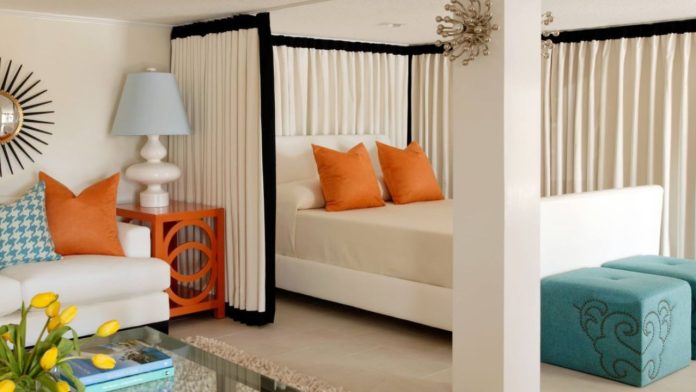One needs to create as much space as possible in the home without sacrificing the aesthetic value of the space or its practical utility. Another common and efficient way of space management explained here is the utilization of curtains for dividing the rooms. This approach enables homeowners to separate parts of a room within a home thereby offering both privacy and beauty. Thus, knowing the advantages and the uses of curtains as room separators people can improve the living space with much ease and little money.
The Versatility of Curtains
Curtains are much more versatile as a means of partitioning space because of the numerous styles, materials, and colors. Unlike walls, curtains are easy to fix and remove, thus making them suitable for people who live in rental houses or those who change the interior of their houses often. They are made of different kinds of fabrics from sheer fabric to heavy fabrics, thus enabling users to regulate the amount of light and visibility. Moreover, curtains can be matched with the other accessories in the rooms, which will make the room look elegant or casually comfortable.
Advantages of Curtains as Room Separation Tools
- Cost-Effectiveness: In terms of costs, curtains are cheaper than other possible ways of room division such as using walls or having a new room added. They offer a short-term solution that does not need much money to be spent. They are ideal for those with limited funds or those who live in apartments.
- Privacy and Acoustics: Curtains may not block the sounds totally but they are effective in offering some form of acoustic privacy. This way, thick material can also be used to reduce noise levels and establish more separated zones in the open concept design.
- Aesthetic Appeal: Curtains are available in many types ranging from sheer type to luxurious types. Such features enable people to choose options that match their interior décor to improve the appearance of the area in addition to the functionality of the item.
How to Select Curtains for Division of Space
When selecting curtains for room separation, several factors should be considered to ensure they meet both functional and aesthetic needs:
- Fabric and Texture: The fabric used in the curtains is very important in determining the performance of the curtains. Voile or sheer cotton is the best type of material to use for a soft division that will not exclude light. Thinner fabrics such as silk or organza offer less privacy and less partitioning while thicker materials such as velvet or thick linen offer more privacy.
- Color and Pattern: Curtains are known to affect the mood and how a room is perceived in terms of size and shape. Neutral colors and plain patterns are usually versatile and can easily complement any interior design whereas bright colors or complex patterns can be more of a statement and can be used to section off an area within the room.
- Installation Method: Some of the methods of hanging curtains for room separation include the use of ceiling-mounted tracks, tension bars or rods, and conventional curtain rods. It depends on the appearance that is being sought after and the architecture of the room. Ceiling mounted tracks are sleek and contemporary and tension rods are easy to install and remove without the use of screws.
- Length and Width: Curtains should also be of the right size for the room as this helps in getting the best results. If the more dramatic effect is desired, curtains can be made to go from the ceiling to the floor. The width of the curtains should be enough to cover the area to be covered together with additional fullness to get a rich, luxurious drape.
Application in Different Settings
Curtains for room separation can be utilized in various settings, each benefiting from their unique properties:
- Living Rooms: In the context of open space living, curtains can partition the space into different areas for example a reading area from the general sitting area. This makes it possible to have a well-arranged and functional living space.
- Bedrooms: Blinds can also be used to separate sleeping areas or to make separate areas in a single room. For instance, a curtain can divide a child’s sleeping area from a playpen or a home office.
- Home Offices: In a home office, curtains can be used to separate working areas from other areas of the house, and give the ability to change the layout of the room depending on the work or the meeting.
- Studios and Apartments: When people live in small houses, curtains can be very useful in separating the bedroom, the living room, and the dining area. This is especially useful where space is limited like in studio type of houses or apartments where space is of essence.
Conclusion
Hanging curtains for purposes of partitioning the rooms is a unique and effective way of increasing the flexibility of home space. As they are affordable, easy to install and give the room a stylish look, curtains are a great way of partitioning and creating personal space in the house. If the homeowner takes his/her time to choose appropriate fabrics, colors, and the right method of installing the fabrics then they will be in a position to create a beautiful and practical space for living as per their desires.













